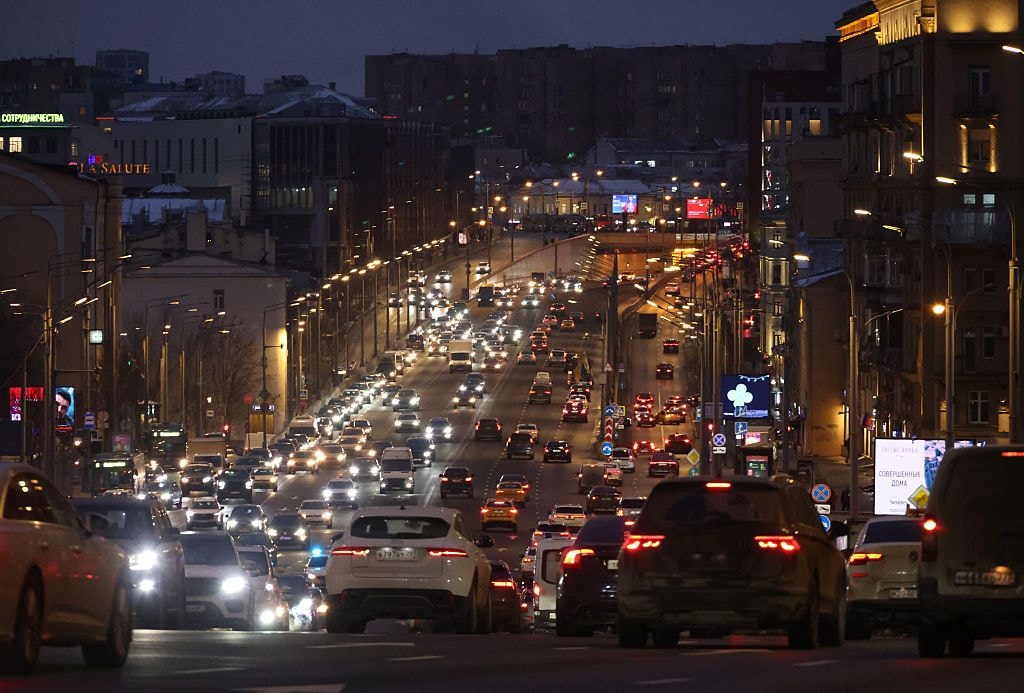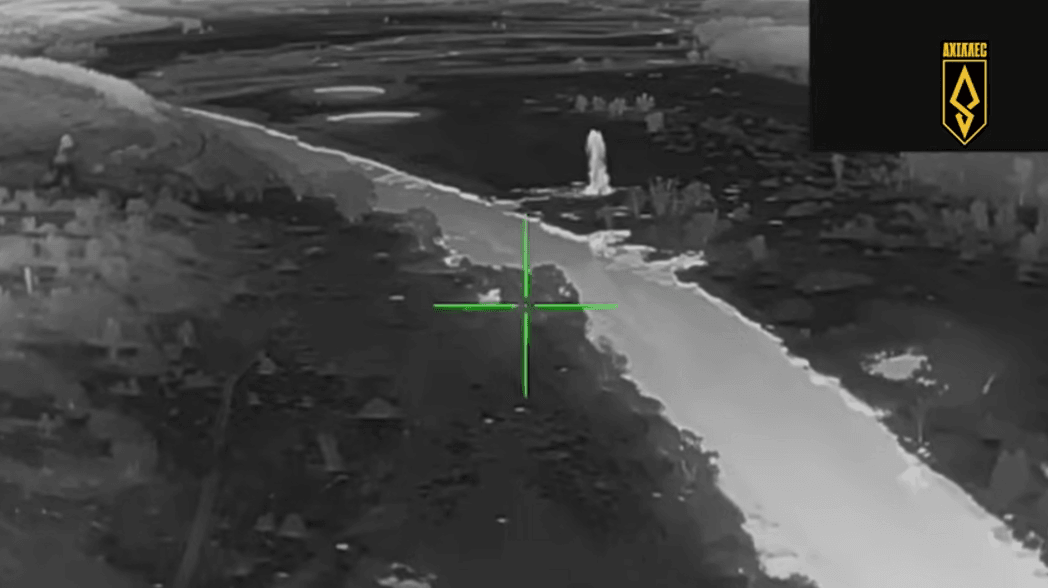
As Russians inch closer to Pokrovsk, civilians in the area are left with a choice — stay under fire or leave life behind
Women sit inside a bus as civilians are evacuated from the front line city of Pokrovsk, Donetsk Oblast, Ukraine, on Dec. 28, 2024. (Wolfgang Schwan/Anadolu via Getty Images)
BILOZERSKE, Donetsk Oblast — Less than 30 kilometers north of embattled Pokrovsk, a market was in full swing in the town of Bilozerske.
Meters away, however, a crowd has gathered in front of a building, nervously awaiting the doors to open. Tensions were visibly mounting as the doors remained closed and impatience settled. An umpteenth air raid siren reminded everyone about the never-ending threat from Russian drones and glide bombs in the area.
Nobody seemed to care about a potential attack. People were waiting for hours at the distribution point, seeking their turn to receive hygiene kits and water supplies. No one seemed to want to lose their place in the queue.
Anastasia Olekh, from the Caritas Mariupol non-government humanitarian organization, said that Bilozerske remains full of people in need, becoming a safe haven for those fleeting towns and villages closer to the front line.
“Prior to the full-scale invasion, there were around 15,000 people here. Since 2022, many have left, but we also saw an additional 5,000 displaced people coming from settlements of the Pokrovsk district directly under fire,” Olekh said.
The city of Pokrovsk, which once counted some 60,000 residents, now counts a mere 11,000, with Russian troops aiming to surround and occupy it while gradually turning the city into rubble.
“So far, Bilozerske has not been too affected by war, and its coal mine is still open, which means there is still work for civilians, but the living conditions are dire,” Olekh added.
Trapped near front
Valentyna, a 65-year-old resident of Bilozerske, has chosen to stay in the town with her husband and their dog. Valentyna says she is aware of the danger, yet chooses, for now, to not leave because of the lack of funds and opportunities elsewhere.
“Compared to Sloviansk, Kramatorsk, or Pokrovsk, it is safer here as long as we are not being shelled,” she said.
“We know that when they (the Russians) will reach Pokrovsk, they will try to finish us off here as well. But we simply don’t have anywhere else to go,” she added.
“We know that when they (the Russians) will reach Pokrovsk, they will try to finish us off here as well. But we simply don’t have anywhere else to go.”
Valentyna’s biggest fear is glide bombs, which Russia has been increasingly using in 2024.
“Since they have started to launch them, we no longer feel safe. Our air defense can shoot down missiles, but not glide bombs; those are just terrible; that’s why we are hoping for some kind of truce, through diplomatic channels, so that those bombs no longer fly,” she said.


Not far from Valentyna, Olena, 42, was also standing in the queue.
Olena used to work on a farm near Bilozerske, where she lives with her family. “I’m here with my 15-year-old daughter and my five-year-old son,” she said, adding that she also takes care of her mother with cancer, thus unable to leave the town.
“My main worry is my children, right now, they are cut out from the world,” she added.
Not far from the queue, local residents Svitlana and her husband were loading a month’s worth of water supplies in their car. The retired couple from Bilozerske had no intention of leaving. Over the deafening sound of sirens, Svitlana seemed annoyed even at the thought of evacuation, although theoretically, it is mandatory in the area.
“Look, my husband and I are both 72. We have lived in Bilozerske for the last 50 years. We got married here, our children grew up and were baptized here, what is the point of leaving? Obviously it is scary, but no, we will not be leaving,” she said.

Whether bound by financial constraints or memories of peaceful times at home, most civilians feel they have nowhere else to go, and while Bilozerske doesn’t – yet – lie directly in the combat zone, some, who have already relocated once, simply feel trapped here for lack of better options.
Anastasia came from Toretsk, which has seen some of the heaviest fighting since 2022. According to Ukraine’s military, the fighting is currently ongoing in the town’s streets.
“I’ve already moved once, a year ago, as the situation has become unbearable in Toretsk. Our flat has since been looted and then destroyed. I was already used to living in combat zone, so in comparison, things have been quiet here,” Anastasia said.
“Anyway, I can’t afford to move further away from the front line, you just have to look at the steep price rise for flats in Dnipro, in Poltava, for example, to understand why we stay here,” she added.
Leaving life behind
Those who have relatives elsewhere or take safety over the potential hardship far from home make their way to Pavlohrad, in nearby Dnipropetrovsk Oblast.
Following the Russian offensive targeting Pokrovsk, the city of Pavlohrad became the new evacuation hub for those fleeing the embattled Donetsk Oblast.
Once home to 100,000 people and located 100 kilometers west from Pokrovsk, Pavlohrad is now overcrowded with people desperate to flee and officials and volunteers helping them get by.
Around the clock, cars, buses, and vans are bringing those evacuated from Donetsk Oblast. What had been a theater hall is now a dormitory for those awaiting their train or bus further west.


Seats have been piled at the back of the hall to make way for folding beds. Blue care packages from the United Nations lie around. The theater hall is silent, but each of its residents bears the traces of war: in semi-darkness, a handful of elderly wait to be brought to a more permanent accommodation, surrounded by a few plastic bags containing all of the belongings they were able to take with them.
Near the stage, a woman was sitting in a state of shock, surrounded by her two dogs. She came from Kurakhove, and counts among the last people evacuated from the city.
On Jan. 6, Russia declared it had captured Kurakhove, a bombed-out town, the population of which decreased from 18,000 to a mere 2,000 people since the start of the all-out war.
Exhausted, the woman can barely speak, and is in need of medical treatment. Near her, an elderly man with crutches was sitting on his bed, where he was taking notes in a small notebook, using his mobile phone as a torchlight. Another woman muttered unintelligible words to herself, folding and unfolding a few clothes on her bed.
In the corridor, Viktor, 66, a former miner, has just arrived from Myhrnohrad. His eyes were hollow, he was still shaking.
Sitting on a bench, he was waiting for registration and would go whenever he was sent as long as it was safe.

“There were soldiers in the streets, my city is no longer accessible and constantly under shelling. I don’t have anywhere to go, nor do I want to get in touch with relatives in safer places. I heard I would go to a shelter in Kyiv Oblast,” Viktor said.
"There were soldiers in the streets, my city is no longer accessible and constantly under shelling."
Disoriented and weak after having spent months with no water, no electricity, and no heating, Viktor followed humanitarian workers in the hall, where he would await a commute to his Kyiv Oblast accommodation. He said he knew he might never come back home.
An evacuation was called by authorities of Donetsk Oblast during the summer and autumn, with police, the military and local and international NGOs helping with the evacuation effort.
The work is carried out at great risk, as the Russian troops routinely use drones to target civilians and humanitarian workers all over the region.
Despite the calls from officials, as of mid-December, around 300,000 civilians remained in Donetsk Oblast, out of which 54,000 lived directly in an active warzone, according to the Donetsk Military Administration.
When asked why they would not leave the danger zone, those who spoke with the Kyiv Independent named two reasons — tough decision to leave home and lack of opportunities elsewhere.











